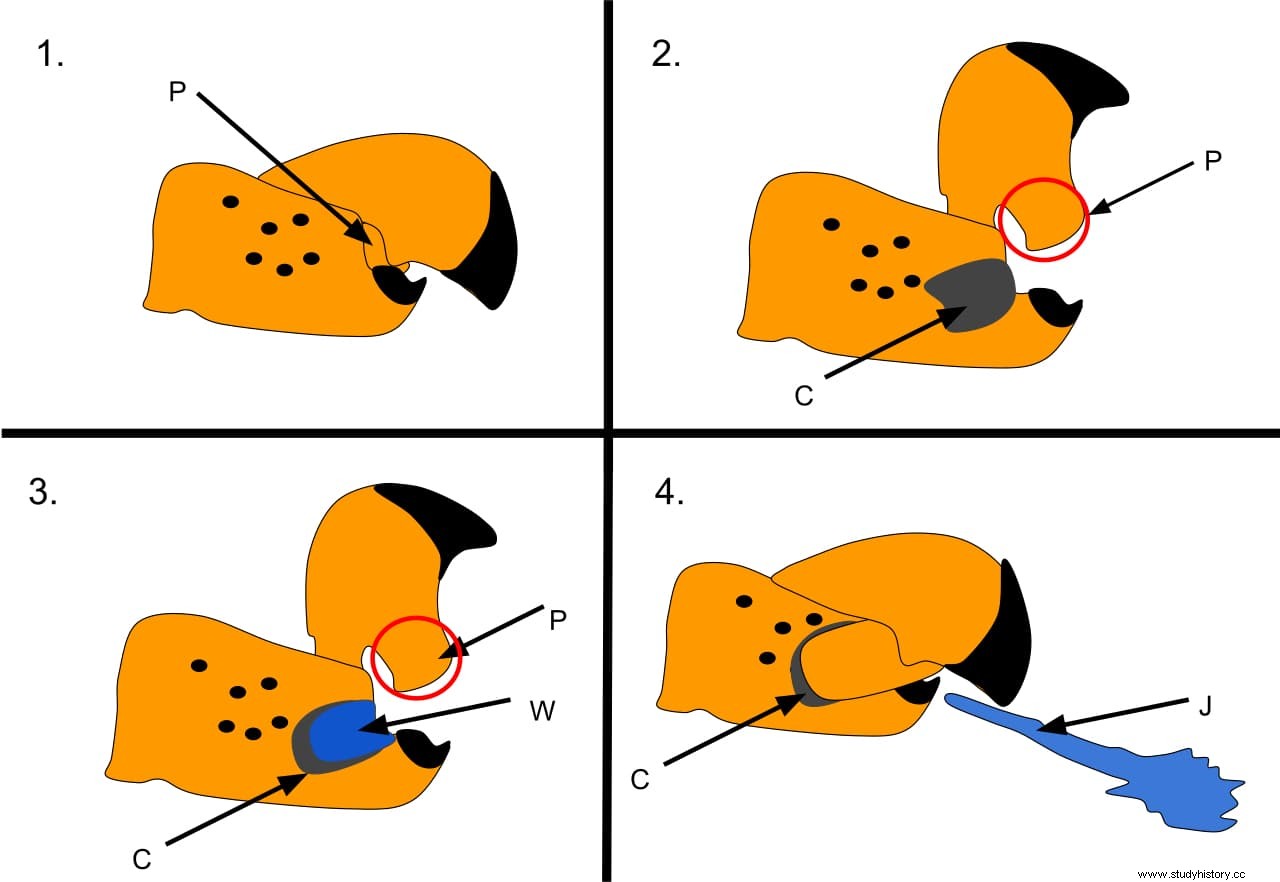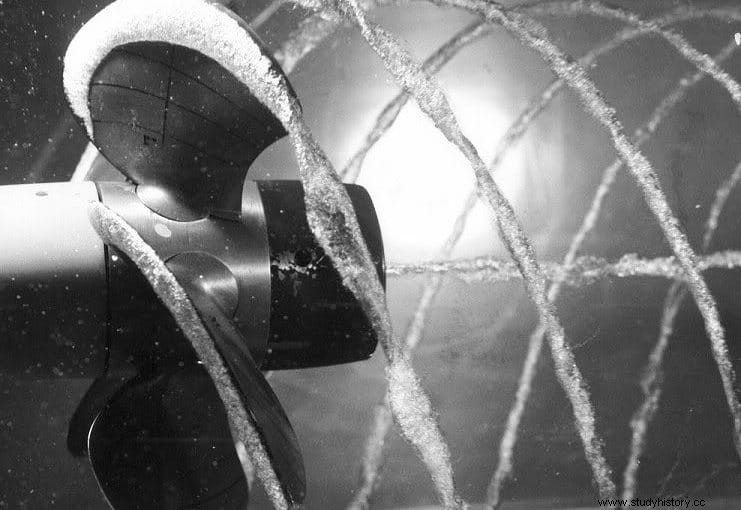We have already spoken before about the participation of animals in the wars that humans maintain against their peers. Most of the time, this intervention is usually as a weapon (horses, elephants, dogs, etc.), although other times it is merely the trigger for the explosion, in the case of that dog that unleashed a fight between Greece and Bulgaria or the locusts that were about to do the same between France and Brazil. Today we are going to see another in which crustaceans are once again the protagonists:the shrimp that had their share of prominence in World War II.
Not just any shrimp but those of the alpheida family (Alpheidae ), which belong to the suborder Caridea. They are popularly known as biting shrimp and they are very small, measuring only between three and five centimeters in length, which is very convenient for them to find shelter in the hollows of coastal rocks and coral reefs, some in warm waters, others in colder ones.
Its name derives from the weapon used to hunt, the cheliped, an arm -only one- disproportionately developed -almost half of its body- and ending in a pincer.

But it is not a pincer like that of other crustaceans, since, first, it can regenerate itself in case of amputation and, second, it does not open and close like those of other species. It consists of a joint that lifts one of the parts until it forms a right angle, and then suddenly releases it and allows it to fit automatically with the other. That is to say, it works in a similar way to the firing pin of a pistol, hence in English this animal is also called pistol shrimp , that is, pistol shrimp. Now, as curious as this system is, the effect it produces when it works is even more so.

Thus, when a shrimp hidden in its dark hiding place detects a prey, thanks to the tail flicks of the goby, a fish with which it shares a home in symbiosis, it quickly takes out its claw, raises the hammer and, when it closes, in a thousandth of a second produces a powerful wave of bubbles that kills or stuns its victim, usually an invertebrate but sometimes larger fish.
In fact, it has been proven that this shock wave has enough force to break small glass jars, something that makes the simile of the gun even clearer.
But it still produces another surprising effect:sonoluminescence, which is the generation of light (not visible to our eyes) in a liquid due to ultrasound, something explained by the rapid collapse of bubbles in cavitation; This consists of the formation of voids or bubbles due to a reduction in pressure below that of the liquid, which when it rises again causes its implosion at a temperature of around 7,700º. The stomatopod or mantis shrimp, which is larger than the snapper, also uses a similar hunting method.
Biology aside, what is interesting here is that when alpheids live in colonies they become one of the noisiest species in the marine world, generating a sound level comparable to that emitted by those who hold the record, the cetaceans.
How? Well, precisely through this unique hunting resource:the closure of the pincer-percutor has a pressure of up to 80 kilopascals and the bubbles are released at a speed of a hundred kilometers per hour, all of which is equivalent to about 218 decibels; sperm whales, for example, are around 230 decibels and belugas around 140.

This sensational evolutionary adaptation has been known since the end of the 18th century, although at that time it was thought that there was only a click produced by the closing of the claw and used as a mating call. It was not until 1999 that Detlef Lohse, a young German physicist from the University of Twente (The Netherlands), a specialist in fluid mechanics, saw a printout with an acoustic record of the Munich Aquarium shrimp and thought he identified a pattern similar to the one he was using in his work on cavitation. The fact that biologists told him that bubbles were also formed made everything clear to him and he decided to prove it empirically.
Lohse created a series of theoretical models and then, to finally convince the zoological academic world, he placed several microphones and a high-speed camera underwater next to the burrow of an aquarium shrimp; then he tickled the tenant with a brush (actually he used seven) and he reacted aggressively.
The images demonstrated the generation of a high-velocity jet of water by engaging a protrusion of the caliper with its corresponding hole. High speed means low pressure and the appearance of bubbles, which when they move away from the pincer implode into thousands of smaller ones capable of stunning or even dismembering prey.

The most exciting thing was verifying that the process included a heat similar to that of the sun's surface (although for a very short time), sound (not produced by the collision of the two parts of the clamp but by the collapse of the bubbles) and light (although the 50,000 photons originated could only be recorded thanks to a highly sensitive photodetector).
Lohse says that he and his team (made up of Barbara Schmitz, Michel Versluis and Anna von der Heydt) baptized it as shrimp poluminescence… at a bar counter while celebrating their success over a beer. In fact, the German is still jokingly nicknamed the shrimp boy .
So now let's imagine a colony of alpheids, usually made up of hundreds of individuals (and there are over 620 different species) firing their guns one after another. time (see video)? Because, in addition, the snapping of the clamp helps them communicate with each other, so that the organized hubbub would reach a level capable of altering underwater acoustic communications, including sonar. And this matters when the world is at war and the oceans constitute a vast battlefield, both above and below the surface.
This is what happened in 1944, when someone realized the benefit that could be derived from it and informed the US Navy. Apparently, the naval technicians had the idea of using the noisemakers of the alpheid colonies as acoustic screens against the hydrophones installed in the ports of Japan. A hydrophone is a transducer device by which a sound produced in an aquatic environment can be transformed into electricity, so that it can be identified. They began to be applied to submarines during the First World War and were the starting point for the development of sonar in the 1920s.
Moreover, the Royal Navy had detected that the propellers and rudders of its ships were being damaged by the cavitation bubbles generated by the former and in 1916 commissioned the physicist Lord Rayleigh to study a way to minimize them. Rayleigh failed and was only able to provide a description of the process; yes, it was a sufficiently detailed work so that, in part, it served as the basis for Detlef Lohse's experiment eighty-three years later.

Meanwhile, World War II came and sonar seemed to have ushered in a new era in submarine warfare, making surprise attacks on ports difficult. But, as we said, the American submersibles took advantage of the abundant alpheid colonies that exist on the Japanese coasts to move around them and along those of other Pacific coasts, masking the noise of their engines; they were also used later, during the atomic tests in Bikini, to verify the deadly effects of the device (the decrease in acoustic records indicated the absence of life forms).
After the fight, it was learned that the swim bladders of fish and jellyfish, full of gas, also contributed their grain of sand to the confusion, by creating echoes in the so-called DSL (Deep Scattering Layer , deep scattering layer), a marine subaqueous layer that sound does not pass through and was often mistaken for the bottom.
The fact is that these phenomena are still of interest today and the DARPA (Defense Advanced Research Projects Agency, the Pentagon's research and development agency) is studying them to apply them to the detection of submarines.
